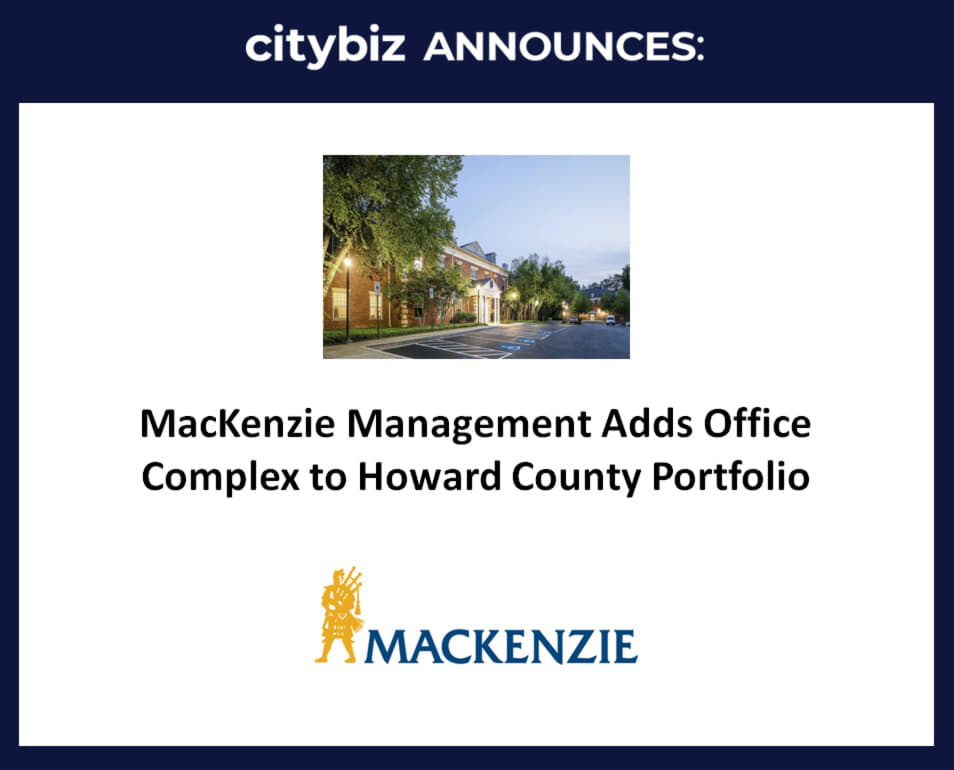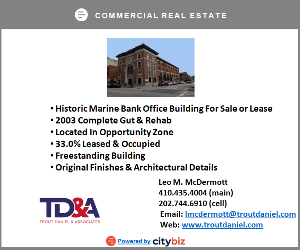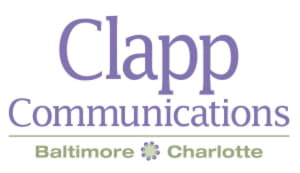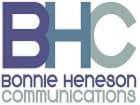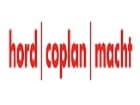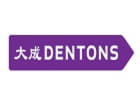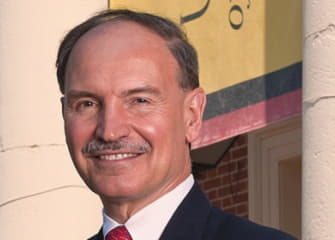
Bob Chrencik
Click here for Part II & Part III
Bob Chrencik, President and CEO of the University of Maryland Medical System, highlights the growth of UMMS as a university-centered medical system since its founding in 1984. “We are all about serving patients across the state of Maryland every day,” Chrencik says. Today, UMMS not only includes hospitals and regional health systems, but a full spectrum of health related services. Earlier this month, UMMS affiliated with Dimensions Healthcare System (DHS), which will now be known as University of Maryland Capital Region Health, serving residents of Prince George’s County and Southern Maryland. UMMS works in close partnership with the University of Maryland School of Medicine, chartered in 1807 as the first public medical school in the United States. UMMS operates its flagship academic hospital, the University of Maryland Medical Center in Baltimore which is also home to the world-renowned R Adams Cowley Shock Trauma Center and the nationally-recognized Greenebaum Comprehensive Cancer Center. Other UMMS member hospitals serve urban, suburban, and rural communities across the State. UMMS has also evolved to include University of Maryland Medical System Health Plans, a wholly-owned company offering insurance programs for Medicare and Medicaid beneficiaries, and the University of Maryland Quality Care Network, a provider-organized network of physicians and other health care providers in the state, and other health care providers in the state. Mr. Chrencik discusses how UMMS, with 25,000 employees and revenue of $4 billion annually, is well-positioned in the complex and highly competitive Maryland health care marketplace and how the environment is changing from in-patient focused health care delivery to managing the health of patient populations.

EDWIN WARFIELD: Give us some background. When did you start your career at the University of Maryland Medical System?
BOB CHRENCIK: I worked in public accounting, originally with PricewaterhouseCoopers and then ultimately with KPMG’s healthcare consulting group. I’m a CPA/MBA-type, and have a lot of knowledge of financial issues in the healthcare industry. I was working on a consulting engagement in the late ‘70s over at the University of Maryland Medical Center. It was an organization that struggled mightily at the time. It was not well governed through the university, it had problems with accountability, it lost money on a pretty regular basis, it did not have a strong management team. It really had a public hospital culture. It felt and looked like a public hospital. It didn’t have that private enterprise feel.
I worked with the CEO at the time, Dr. Morton Rapoport, a wonderful human being, as a consultant. We talked about the potential of the organization. It was like a car—you could pick up the hood and you could say, “You know, if we could connect this, this, and this, this thing could be special.” So, we took a look at that. We said, “What would make the difference here?” And the difference would be privatization: taking it out of the state, putting it into a nonprofit corporation, getting the right governance and the right leadership. And we were very blessed in that. Beginning July 1, 1984, the University of Maryland Medical System was created as a 501(c)(3) corporation. Governor Hughes at the time appointed a wonderful board chaired by Frank Gunther and other business leaders: Hank Butta, George McGowan, and others. We were very blessed there. I came over from consulting and became the first CFO. Dr. Rapoport was the CEO. Off we went. The plane took off! It had no history of being able to fly all that well.
You could break our history into a couple of short periods: the ‘80s—from the privatization in 84, to about 1990 was a period of focusing on having the trains run on time. I was totally operations-focused: blocking, tackling, getting the right people in place, making sure we were delivering the right services, and—importantly—making money. It was important that we stem the previous history of losses, make money, and create some deck capacity. And we did.
There was a huge competitive gap in this market between the University of Maryland Medical Center and Johns Hopkins. Beginning in the ‘90s, we began to recapitalize the old facilities at the University of Maryland Medical Center. We first built the Shock Trauma Center in the early ‘90s. Then we built a large tertiary care clinical tower called the Gudelsky Building in the mid ‘90s. We followed that in the early 2000s with a very large facility called the Weinberg Facility. And since then, we’ve built some other large buildings, and so we recapitalized the facility largely in the ‘90s and the early 2000s.
Concurrent with that, our big partner, the University of Maryland School of Medicine, was on the move. Being quite honest, this was a pretty average public medical school in the ‘60s, ‘70s, but in the ‘80s and ‘90s, the state invested a lot of money in the medical school. All of the doctors who practice at the University of Maryland Medical Center are faculty of the School of Medicine, so the capabilities of the organization were highly dependent on the depth and the quality of that faculty. The ‘80s and the ‘90s were a period where the University of Maryland School of Medicine was on the move, and it began to recruit a much deeper, much more capable faculty.
Two things intersected in the late ‘90s: one was the enhancements to the medical center and the hospital, and the other was the enhancements to the physicians and the faculty, and the capabilities rose tremendously, which closed the competitive gap to Johns Hopkins pretty significantly. Now, a lot of people wouldn’t know this, but one of the roles of a state university academic medical center is to train the next generation of physicians and other medical leaders for that state. Go to any state—you go to Ohio, you’ll see Ohio State; Iowa, Iowa. Here, the University of Maryland has trained over half the physicians who practice medicine in the state of Maryland. That’s one of our key roles. Johns Hopkins [has] a much, much smaller number.
And so we have a huge following out there of our trainees all across the state of Maryland, but what happened here in this market in the late ‘90s is things began to change a lot. HMOs and managed care came in in a major way, and many community hospitals then said, “Geez, can I make this on my own or do I need a bigger partner?” The good news for us was we had become much more capable. We were private, we had our own deck capacity, we had no strings with the state, we could move fast, we had a great medical school on our shoulder, and we just quietly, beginning in 2000, began to talk to community hospitals where we knew a lot of the doctors. We knew our way around the state, we were quite knowledgeable—and that is one thing that defines us. We are—read our name: University of Maryland—we are about the state of Maryland.That’s where we focus. Some of other competitors—Johns Hopkins, MedStar—they operate a bit outside the state. We are all about the state of Maryland every day, every waking hour of every day.
We quietly began to talk to community hospitals about joining our system or partnering with our system. Since then, we have quietly and systematically built out a large, academically centered health system now of 12 hospitals across the state with about 25,000 employees and about $4 billion of revenue. We are here in Maryland, the biggest healthcare system. It’s a very capable organization. I would say this for the citizens of Maryland: this is a huge asset to the state in many, many ways, and it’s your academic medical center and system in many, many ways. We’re getting ready to head to Prince George’s County and expand the system a little further.
Connect with Bob on LinkedIn
Sponsored by:
Founded in 1993, WMS Partners is the only independent multi-family office in the Baltimore area that isn’t associated with a brokerage firm, bank or trust company. Our team of approximately 50 professionals and 14 owners spanning three generations assists in the direction of our client’s financial goals and objectives and oversees in excess of $3 billion in assets.
As our client’s advocate and central point for their financial affairs, we work pro-actively with service providers, including accountants, attorneys, consultants, insurance professionals and philanthropic advisors. We are large enough that we provide exposure to many unique ideas and strategies in the investment, estate, tax, financial advisory and risk management arena; but small enough to provide discreet, pro-active individualized guidance.


Edwin Warfield, CEO of citybizlist, conducts the CEO Interviews.
If you're interested in reaching CEOs, please contact edwin.warfield@citybuzz.co
Connect on LinkedIn



